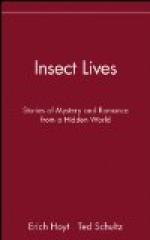The adult dragon-fly (fig. 8 d) is specialised in such a way that it captures its prey—flies and other small insects—on the wing, swooping through the air like a hawk and feeding voraciously. The head is remarkable for its large globular compound eyes, its short bristle-like feelers, and its very strong mandibles which bite up the bodies of the victims. The thorax bears the two pairs of ample wings, firm and almost glassy in texture, and its segments are projected forward ventrally, so that all six legs, which are armed with rows of sharp, slender spines, can be held in front of the mouth, where they form an effective fly-trap. The abdomen is very long and usually narrow.
A female dragon-fly after a remarkable mode of pairing, the details of which are beside our present subject, drops her eggs in the water, or lays them on water-weeds, perhaps cutting an incision where they can be the more safely lodged, or even goes down below the surface and deposits them in the mud at the bottom of a pond. From the eggs are hatched the aquatic larvae which differ in many respects from the imago. The dragon-fly larva has the same predaceous mode of life as its parent, but it is sluggish in habit, lurking for its prey at the bottom of the pond, among the mud or vegetation, which it resembles in colour. The thoracic segments have not the specialisation that they show in the imago; the abdomen is relatively shorter and broader. The larval head has, like that of the imago, short feelers, and the eyes are somewhat large, though far from attaining the size of the great globular eyes of the dragon-fly. But the third pair of jaws, forming the labium, are most remarkably modified into a ‘mask,’ the distal central portion (mentum) being hinged to the basal piece (sub-mentum) which is itself jointed below the head. The mentum carries at its extremity a pair of lobes with sharp fangs. Thus the mask can be folded under the head




